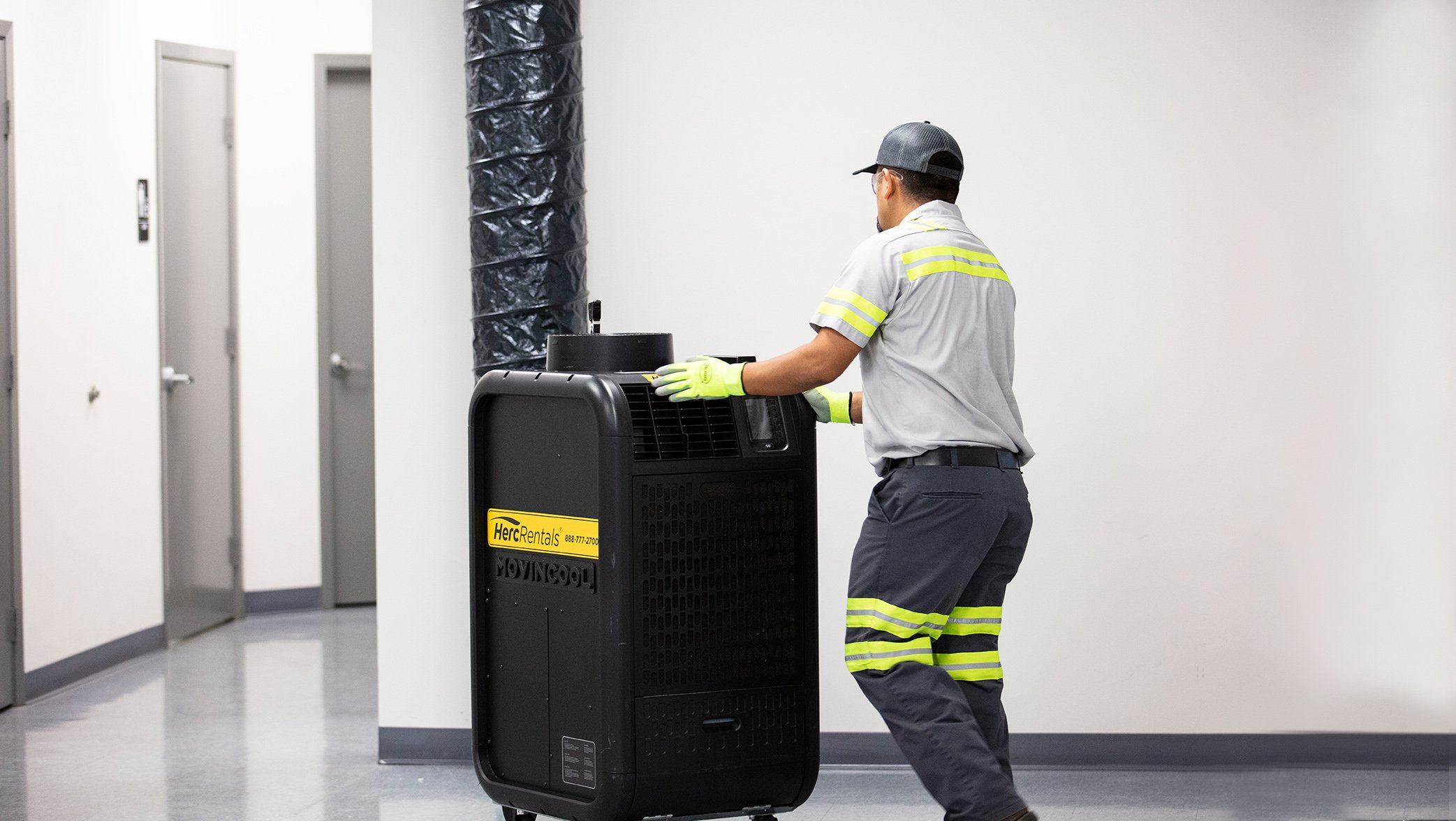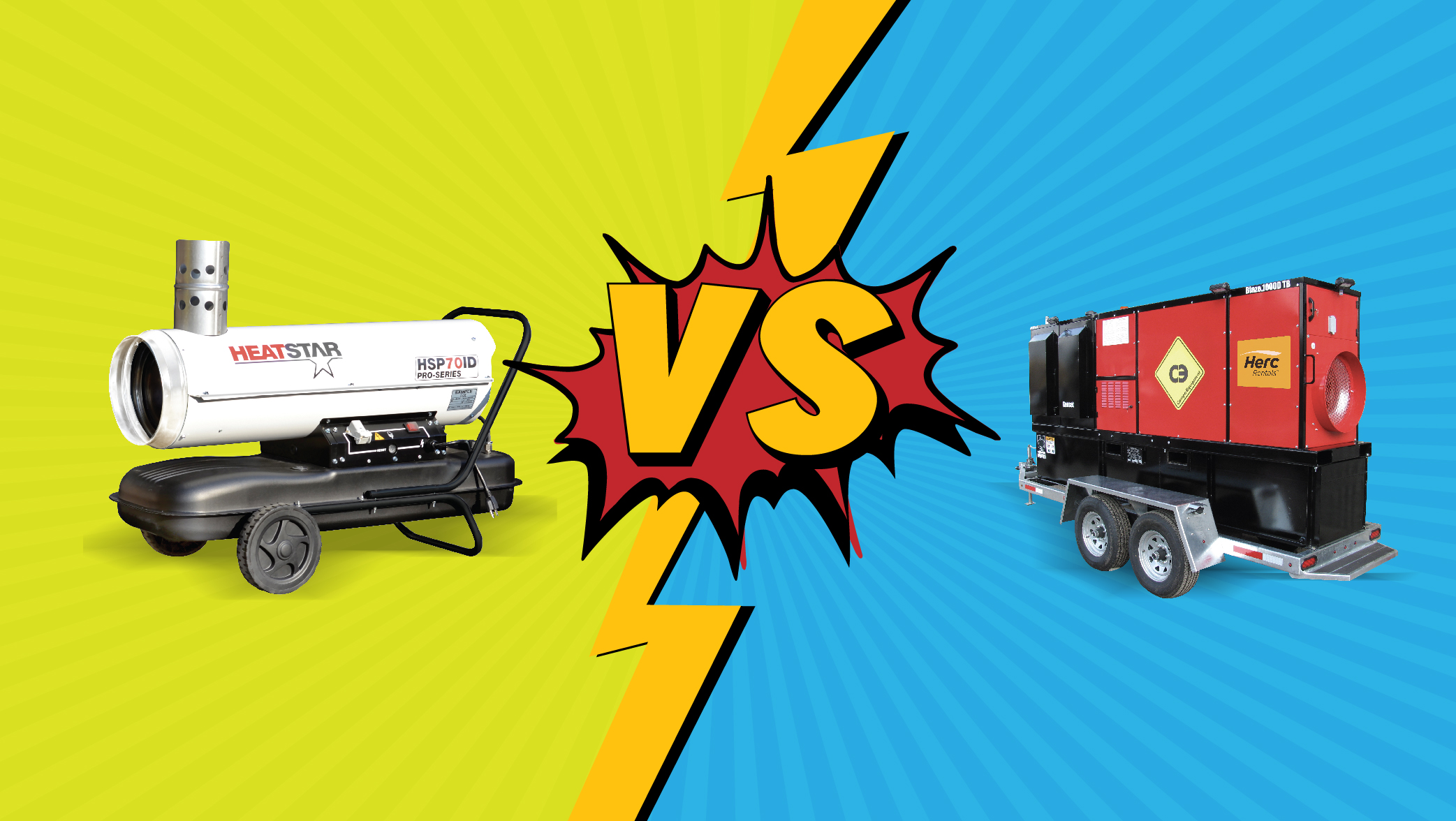Fall is here and winter is knocking on the door all over the U.S. and Canada.
And with the arrival of bone-chilling temperatures, contractors and construction teams need to know exactly how they will handle the cold while also keeping winter projects on schedule.
Many rent portable heaters.
“Contractors rent portable heaters for a number of reasons,” said Ryan Creighton, a Herc Rentals district sales manager based in Newark, NJ. “Creature comfort to keep work crews safe from the cold and maintain productivity; for wet trades like concrete curing and other material that’s temperature sensitive; for the drying of finish materials and to prevent moisture-related movement in wood framing; and to keep pipes from freezing.”
How Low Temperatures Affect Workers and Construction Schedules
Just like extreme heat in summer can result in jobsite injuries and a loss of productivity, extreme cold can do the same.
“Environmental conditions can impact traction on snow or ice, dexterity (due to increased layers of clothing), and visibility,” explained Herc Rentals’ Senior Safety Director Bill Cobb. “This requires team members to slow down and reevaluate routine tasks based on new conditions that have potentially changed the hazards and risks or the approach to the task at hand.”
Cold can also have a negative impact on equipment, Cobb added. “Preventative maintenance must be in place to ensure all tools and equipment can perform when needed,” he said.
Understanding the Cold’s Impact on Materials
While the human body acts and performs differently in cold temperatures, construction materials also react differently in lower temperatures, said Jay Kranker, a Herc Rentals’ ProSolutions segment key account representative.
“When materials are installed in low temperatures, they can change or react differently once temperatures regulate later on in the project,” he said. “This is one of the many reasons specifications are put in place for the installation of different materials. The structural integrity of buildings can be at risk if specifications are not followed.”
Materials affected by cold or freezing temperatures include wood, steel, concrete, paints, adhesives/glue and more.
- Adhesives and Glues — Cold temperatures can freeze water-based adhesives during transportation and storage. They also tend to have a slower setting time since water releases more slowly in the adhesive. In cold temperatures, glue films won’t form properly.
- Wood — With cold weather comes dry weather. In the winter, the project’s wood materials will shrink to an extreme. When a thaw arrives, the wood will start to expand with the increased moisture.
- Steel — When temperatures fall below freezing, all steel changes from being deformable to being brittle, as increasing cold weakens connections between crystal grains. Instead of bending, the steel will shatter.
- Concrete — The freezing of pore water in curing concrete halts hydration and the curing process. At freezing temperatures, the formation of ice within curing concrete can damage long-term integrity through cracking.
- Joint Compound (mud) — Cold weather conditions can contribute to joint compound bond failure, delayed contraction, beading, nail popping, joint shadowing and board sagging.
- Paints — Low temperatures affect both the application and drying of paint. Alkyd and oil paints, based on natural oils and resins, become thicker in lower temperatures and require thinners to be added. Some paints are, however, manufactured with special additives to overcome this problem and improve their performance. Other paint problems that can occur in cold weather include:
- Cold temperatures might affect color, causing an uneven appearance.
- Drying will take longer, and a thick top film might form.
- Latex paint is prone to freezing/thawing cycles, so check if it becomes lumpy as a result.
- Because of the potential for lumps, the paint will require more mixing time.
- Latex paint may become thick in colder weather; this can cause it to be harder to get an even coat.
- When doing touch ups after painting in cold weather, the touch up may look lighter than the original, base coat.
Portable Heating Application Examples
Preparing the Site — If you’re breaking ground in the middle of winter, one of the first steps before foundation work begins is ground thawing. The benefit of thawing the ground allows the excavation process to remain on schedule. In this scenario, hydronic heaters or indirect fired heaters in certain applications would be utilized.
Concrete Heating – According to the American Concrete Institute (ACI), concrete placed at or below 42 degrees F (5.5 degrees Celsius) must have heat protection for a proper cure. In this instance, contractors have three choices — protect the pour, use additives or suspend work. There are various methods for protecting a concrete pour, including concrete insulation blankets, propane heaters with tents, etc. There are also portable hydronic heating systems, which can help keep concrete pours at ideal curing temperatures from 65 to 75 degrees F (18-24 degrees C).
Wet Trades/Tempering the Space/Finishes/Pipe Freeze Prevention — Wet trade work (painting, spackling, tiling, etc.) cannot take place unless the space is at least 45-55 degrees F (7-10 degrees Celsius). If steel beams or interiors are too cold, fire proofing material applied to the steel beams won’t stick. During this phase, contractors also want to protect what has been built, and often employ portable heaters to keep pipes from freezing and ultimately bursting.
Why Renting Portable Heaters Makes More Sense Than Buying
There are several reasons why a contractor may choose to rent a portable heater over buying one.
“It’s simply too big of an expense to buy one when you may only need it for a day, a week or even a month,” Kranker said. “It’s a capital expense. Renting is more cost-effective than buying. It doesn’t make sense for a contractor to own a fleet of heating equipment. Where do you store it when you’re done with it? How are you going to transport it?”
There are other reasons for renting too, Kranker said. “They won’t have to worry about routine maintenance on the equipment — and if they use an equipment rental company like Herc Rentals, they’ll also receive the expertise that can help construction crews control temperature as well as humidity. As is true in most solutions, time is money on the construction site. Staying on schedule is crucial.”
For more on heating and other equipment, consult Herc Rentals’ Solutions Guide.


